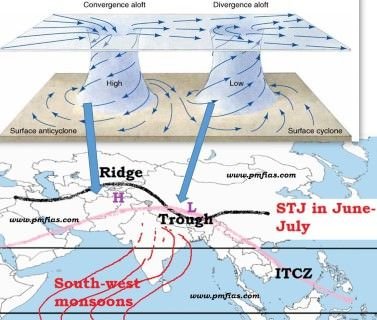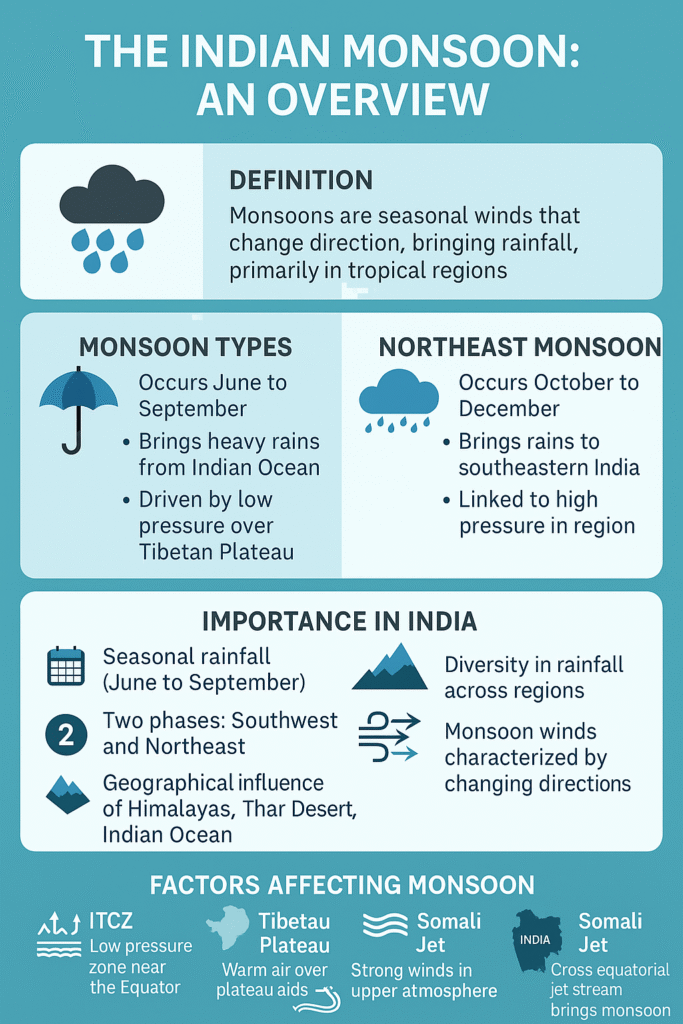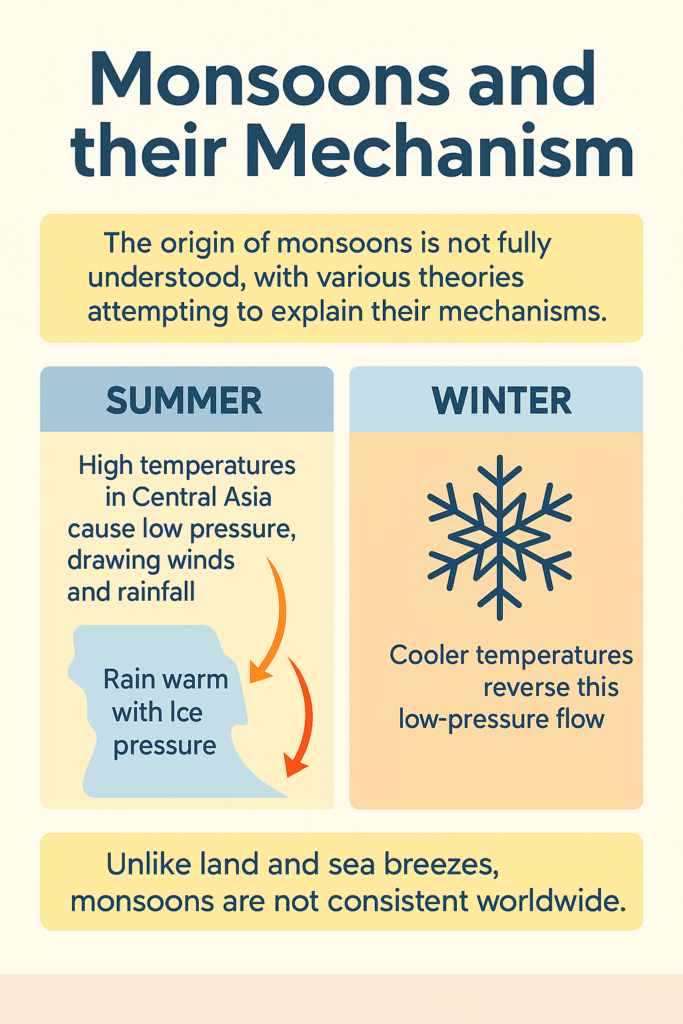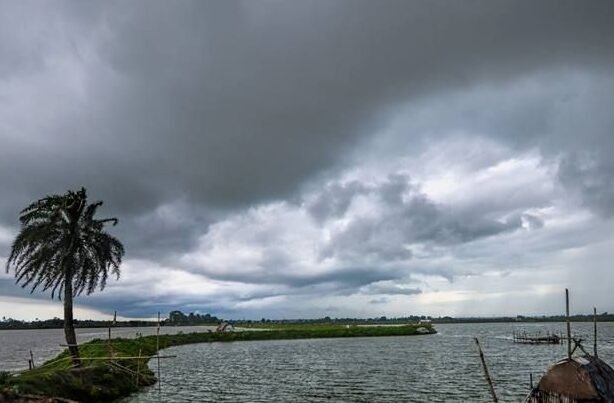Introduction
The Indian monsoon is an important climatic phenomenon that greatly affects India’s weather patterns, agriculture, and daily life. The Indian monsoon brings important rainfall that helps agriculture and refills water sources in the region. It is influenced by various weather and geographical factors.
In this article, we will look into the characteristics, types, factors affecting monsoon in India, and impacts of the Indian monsoon in detail, as it is an important topic for UPSC geography preparation and the Indian monsoon APSC syllabus.
What is Monsoon?
Monsoons are seasonal winds that change direction, bringing rainfall, primarily in tropical regions between 20° N and 20° S. Derived from the Arabic “mausim,” they flow from sea to land in summer and reverse in winter, notably affecting the Indian Subcontinent more than other areas.
What is the Indian Monsoon? An Overview
The Indian Monsoon is an important climatic phenomenon characterised by seasonal shifts in wind patterns that deliver a substantial rainfall to the Indian subcontinent. There are two main monsoon types in India:
1. Southwest Monsoon (June to September)
- Brings heavy rains from the Indian Ocean
- Driven by low pressure over the Tibetan Plateau
- Primarily provides rainfall for India
- Affects neighbouring countries like Indonesia and Bangladesh
2. Northeast Monsoon (October to December)
- Affects southeastern India
- Linked to high pressure in the region
- Contributes to rainfall in Southeast China and Japan
The Indian Monsoon is crucial for the majority of India’s rainfall.
Importance of Monsoon in India
The Indian monsoon season is an important season in India, as it significantly impacts the economy, agriculture, and daily life of the people. Below are some reasons emphasising the importance of monsoon in India:
1. Seasonal Rainfall: Heavy rainfall mainly occurs from June to September.
2. Two Phases: It includes the Southwest Monsoon (June to September) and the Northeast Monsoon (October to December).
3. Geographical Influence: The Himalayas, Thar Desert, and Indian Ocean affect wind patterns and rainfall.
4. Diversity in Rainfall: Coastal areas and the Western Ghats receive heavy rain, while some interior regions may get less.
5. Monsoon Winds: Characterised by changing wind directions that bring moisture from the southwest.
Factors Affecting Monsoon in India
The Indian monsoon climate is caused by changing patterns of air pressure and winds. Below are the factors affecting monsoon in India:
1. ITCZ (Inter-Tropical Convergence Zone)
The Inter-Tropical Convergence Zone (ITCZ) is a low-pressure area near the Equator that shifts seasonally. In June, it brings moisture and heavy rainfall to northern India, while in January, it shifts south, causing dry conditions in the region.
2. Tibetan Plateau
The Tibetan Plateau affects the Indian monsoon by acting as a mechanical barrier and a heat source. It warms the air by 2°C to 3°C in summer, pushing the Subtropical westerly jet southward and creating the Tropical Easterly Jet that travels over the Indian subcontinent and the ocean.
3. Jet Streams
Jet streams are strong winds blowing from west to east at altitudes of 11 to 13 km, found mainly between 20°N to 50°N in the Northern Hemisphere. They are driven by temperature differences and exhibit a wavelike flow.
4. Somali Jet
Temporary jet streams, like the Somali Jet, are crucial for the Indian monsoon. The Somali Jet flows from north to south in winter and reverses in summer, aiding the southwest monsoon’s progression to India and boosting its intensity.
Mechanisms of Monsoon in India
The origin of monsoons is not fully understood, with various theories attempting to explain their mechanisms.
- Summer monsoons occur due to low pressure from high temperatures in Central Asia, drawing winds from the Arabian Sea and Bay of Bengal, leading to heavy rainfall.
- In winter, cooler temperatures reverse this flow.
- Monsoons differ from land and sea breezes and are not consistent worldwide.
Some Theories on the Monsoon Mechanism in India
The monsoon mechanism in India has inspired various theories that aim to explain its complex patterns and dynamics. These theories are important for the UPSC geography preparation.
1. Classical Theory
- Classical theory, referencing texts like the Rig Veda, initially lacked scientific insight.
- Arab traders first studied winds; Al Masudi noted ocean current reversals in the tenth century.
2. Sir Edmund Halley’s Theory on the Indian Monsoon
- Sir Edmund Halley linked monsoons to continental and ocean thermal contrasts in the seventeenth century.
- Halley’s concept fails to account for complexities like sudden bursts and delayed onset.
3. Air Mass Theory
- Modern theories focus on continental shape, orography, and jet streams, making Halley’s theory less relevant.
- The modern Air Mass Theory describes monsoons as modifications of tropical planetary winds influenced by seasonal changes.
Conclusion
The Indian monsoon is important for the region’s weather, agriculture, and economy. The monsoon mechanism in India demands effective prediction and management, especially as climate change alters its patterns.
To reduce negative effects and ensure that monsoons benefit India’s environment and economy, we must adopt sustainable practices and improve weather forecasting. If you are a civil service aspirant, knowing the Indian monsoon thoroughly is important for UPSC geography preparation and the Indian monsoon APSC syllabus.
Frequently Asked Questions (FAQs)
Monsoon season results from differential heating, creating low pressure that draws in moist air and causes heavy rainfall.
The Indian monsoon is a seasonal wind system that brings heavy rainfall to the Indian subcontinent, primarily from June to September, driven by the differential heating of land and sea.
The monsoon starts in India in the state of Kerala, typically around the beginning of June.
The monsoon is crucial in India as it supplies necessary rainfall for agriculture, supports livelihoods, replenishes water resources, and sustains ecosystems and biodiversity.
El Niño weakens the Indian monsoon, causing droughts and agricultural losses.













